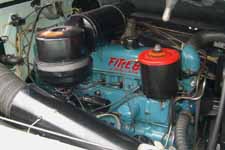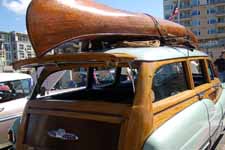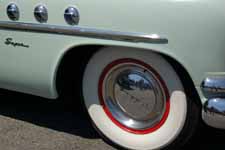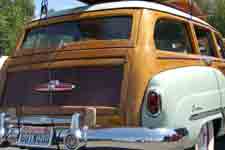|
In 1949 Buick debuted the 5th generation of its popular "Special" (series 40), "Super" (series 50) and "Roadmaster" (series 70) models,
with all new body sheet metal for all 3 lines. Also new for 1949 were the bold "ventiports" chrome trim on each side of the body
(the Special and Super had 3 of these "portholes" on each side and the Roadmaster had 4). The Buick Special model line still did not include
a "woodie" station wagon, but the Super and Roadmaster lines continued to include "Estate Wagon" woodie models, now with
more simplified side wood (but the vertical board on the tailgate and the separate "tailgate" door for the spare tire were carried
over from the 1946-1948 Buick woodie station wagon bodies). For the 1950 models, Buick again changed the woodie bodies on their
Super and Roadmaster Estate Wagons, adding an enlarged "dip" panel to the side wood to meet the bulge in the rear fenders, but
dropping the vertical board on the re-styled wooden tailgate which no longer included a separate "tailgate door" for the spare tire.
1951 brought big changes to the exterior of all Buick models, including the introduction of a new larger front grille (now with 25
chrome teeth!). Buick models also now sported full-length graceful "sweepspear" chrome side molding and stylish fender shields
at each rear wheel well. For 1951, the white ash and mahogany wood station wagon bodies used in the Estate Wagons, were essentially
unchanged from the 1950 designs, and were still built by the Ionia Mfg company in Michigan and shipped to Buick for final assembly.
Like all 1951 Buick "Super" models,
the 1951 Buick Super Estate Wagon woodie came with a chrome "Super" emblem affixed to each front fender beneath the 3 ventiports,
but unlike the other body styles in the "Super" line-up, the station wagon came standard with a leather/leatherette interior
instead of cloth. As in 1950, for 1951 Buick installed its 124 h.p., 263 c.i. "Fireball"
straight-8 engine in the "Super" Estate Wagons. A 3 speed manual transmission was standard, with the Dynaflow 2-speed automatic
transmission available as an option (identified by chrome "Dynaflow" script on each rear fender,
and a cool "Dynaflow" badge on the woody's tailgate).
For 1951, Buick built 2212 "Super" Estate Wagons, and 679 "Roadmaster" Estate Wagons. Buick continued to offer Estate Wagon woodies
for 2 more years, but the Buick Estate Wagons produced in 1953 would be the final year for Buick's woody wagons, and sadly
would be the last wood-bodied station wagons offered by a major U.S. auto maker. Total Buick woodie station wagon production
for 1940-1953 was 20,171 units.
|



















